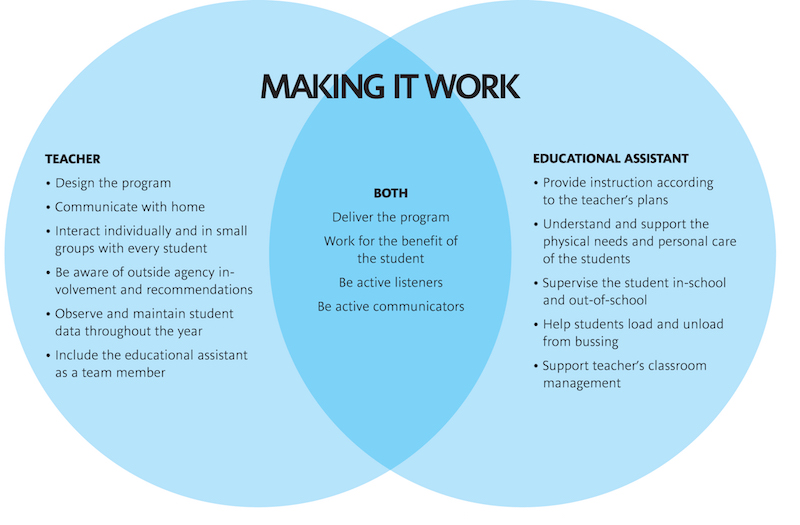
Building Strong Classroom Partnerships
We all hear that positive collaboration is essential to optimizing learning environments, but what does it mean? How do we develop healthy working relationships? When I started my teaching career, it was not clear to me how to work as a member of a team. As a new teacher, I received explicit and ongoing professional development on delivering the curriculum, programming for the needs of all students and reloading the photocopier toner, but no one provided guidelines for building healthy, collaborative working relationships with educational assistants. That gap in my professional development may not be a surprise, however. Guidelines for working relationships are not easy to pin down and resources are not always available.
In my eighth year of teaching, I started in a specialized classroom for youth with autism spectrum disorder that required regular support from four educational assistants. Learning how to collaborate with others was suddenly my first priority. In that classroom, where each student had an individual education plan and required unique programming, there were many ways group tensions or miscommunications could disrupt programming. Fortunately for everyone, I had the pleasure of working with an extraordinary group of educational assistants who modelled professionalism, competence and passion. But even in the best of circumstances, building healthy, collaborative relationships is challenging work.
Let me start off by saying that while I do have some hard-earned lessons to share with you, I also asked my colleagues (long-time educational assistants) for their perspectives.
After reflecting on my teaching experiences, speaking with educational assistants and reading the literature around team building I have three simple rules to propose when building working relationships: (1) know your job, (2) communicate, and (3) be a team.
Rule 1: Know Your Job

Classrooms are dynamic and fluid environments and, in the hustle of an elementary classroom, it may not always be clear who does what. Sure, work gets graded, messes get cleaned, and bookshelves are organized, but by whom? Have you ever come across an exhaustive job list for all that we do? Do you know the job description of an educational assistant? Or a teacher? What classroom tasks are the shared responsibilities of teachers and educational assistants?
Researchers who study the relationships between teachers and educational assistants tell us that working relationships are more effective when the roles of team members are clear and agreed upon. While the application of these roles may differ slightly between different school boards in the province, these are the generally accepted roles played by teachers and educational assistants.
Here is an important question for you to consider: who does the educational assistant actually assist? Do educational assistants assist the teacher in instruction, or do they assist the students in learning? It may seem like a simple question, but research shows that how teachers answer that question predicts how teachers respond to and interact with educational assistants.
By knowing the roles of the teacher and the educational assistant, we can reduce some of the tension around power sharing in the classroom. Take some time to discuss these roles and open the dialogue about expectations. Remember, the roles of educational assistants differ from the roles of the teacher because educational assistants have different legal, ethical and curricular responsibilities. Educational assistants and teachers do different jobs in the classroom, but they do them together, as partners.
From an Educational Assistant Perspective...
“Teachers need to realize they are our colleagues, not our bosses (education assistants report to the administration). Teachers are responsible for the classroom and can provide direction when educational assistants are working with students, but it is not up to a teacher to speak to educational assistants about issues such as attendance or tardiness.”
“Teachers should be well versed in educational assistant roles and responsibilities. Both educational assistants and teachers need to respect that each individual has specific skills and training that qualify them for the job. They need to work together to reach the highest potential within the team.”
Rule 2: Communicate
Have you seen a teacher and educational assistant team that works seamlessly well together? It is a beautiful thing! When two professionals are dedicated to the same goals and strategies, they are capable of more than they would be alone. During stressful classroom moments, the teacher and the educational assistant can share a look and they seem to be reading one another’s mind! Sounds great, right? But, how do you get to that place of professional synchronicity?
The working relationship between teachers and educational assistants can feel a little like an arranged marriage. Teachers and educational assistants may not have chosen each other, but they find a way to make it work. Also like a marriage, the key is communication! Research shows that teacher and educational assistants who make time for scheduled meetings enjoy more positive working relationships. It’s not enough to discuss the day in the hallway while you’re getting your boots on. Here are two ways to improve communication:
Meet early! Don’t wait to meet! Programming is the teacher’s job, but by meeting early in the school year, input from educational assistants can inform the programming decisions.
Meet often! Daily or weekly meetings are essential for communication. Research shows that teachers may perceive that they don’t have time to meet formally or that the scheduled day does not allow for formal meetings. Meeting regularly is a demonstration of a partnership.
From an Educational Assistant Perspective...
“Have regular team meetings, preferably once a week. This should be a time for everyone to share opinions without being judged or criticized. Everyone needs to keep an open mind and understand that what comes out of the meeting may not be what they, as an individual, wanted, but at least each person gets to be heard. We are allowed to disagree. It doesn’t mean we have to be angry with each other. Sometimes people just have different opinions and that is okay.”
Rule 3: Be a Team
This last point is an important one. Building an effective team is more than just knowing your jobs and communicating as much as possible. You have to go out of your way to be a team. After all, school gets messy sometimes, and you are in this together. Be appreciative and empathetic toward each other. We already know that students do their best work when they feel like they are cared for. Why would we expect it to be different when working with adults?
In my room, there was not always time to stop the program to discuss a new idea or strategy. By setting up a suggestion box or a communication binder, the classroom becomes a place where teachers and educational assistants can work together, share ideas and feel like their contribution is appreciated.
From an Educational Assistant Perspective...
“I always like a suggestion box. It gives people a chance to write down their issues immediately and then enables them to move on with the day. It also gives the team leader (teacher, resource teacher, administrator) time to process the issue and come up with the best possible answer. I like the idea of a team communication book as well.”
Pulling It All Together
Developing healthy, collaborative relationships is not an easy task, but it will be worth the effort. Investing in the people you work with every day will help you coordinate and work together. Teachers and educational assistants are at their best when they can find ways to navigate their separate roles, communicate their ideas, and work together. It may not always be easy, but we are all better at our jobs when our working relationships are cohesive and productive. And in the end, it is our students who benefit.
Jeffrey MacCormack is a member of the Simcoe County Teacher Local. He is currently on leave studying at Queen’s University.